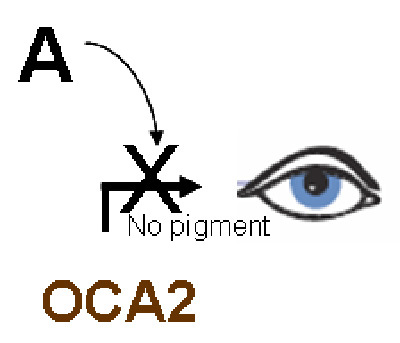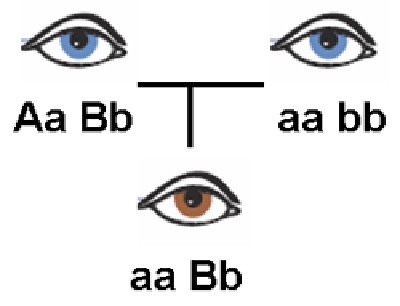
If both parents have blue eyes, how could they have a child with brown eyes?
August 4, 2011

- Related Topics:
- Eye color,
- Pigmentation traits,
- Complex traits
A curious adult from California asks:
“If both parents have blue eyes, how could they have a child with brown eyes?”
That's a great question. Blue-eyed parents can definitely have a brown-eyed child.
If you’re familiar with the standard two-gene model of eye color inheritance, you may have seen that it is “impossible” for blue eyed parents to have a brown eyed child. But as is so often the case in genetics, the truth is more complicated. Which is what makes genetics so fun!
And while we don't yet know exactly how it happens, there are plenty of different ways that it might.
What I want to focus on here is how multiple genes can work together to affect eye color. And how one gene can affect another gene.
Nonworking Genes and Blue Eyes
A big part of eye color comes from the OCA2 gene. When it is working, it makes pigment and gives you brown eyes. When it isn't working, no pigment gets made and you have lighter colored eyes.
From here on out I'll simplify things by referring to "lighter colored" as blue. Understand that the ideas I propose will work for green or hazel or any other color that isn't brown.
The usual way you get a working or a nonworking OCA2 gene is by inheriting it. So there is one version of OCA2 that gives brown eyes and one that can give blue.

But inheriting a broken gene isn't the only way to get a gene that doesn't work. Sometimes one gene can shut off another, different gene.
When this happens, the shut off gene can sometimes be turned back on again. So for our discussion here, a brown-eye version of the OCA2 gene might be off in a blue-eyed parent but on in a brown-eyed child.
Genes that Shut Off Other Genes
Imagine someone who has blue eyes but a brown OCA2 gene. One way this might happen is if they have a second gene that shuts off the brown OCA2 gene.
A shut off OCA2 is the same as having a blue OCA2 gene. Neither makes any pigment and no pigment means blue eyes.
The difference, though, is that unlike having a blue OCA2 gene, a shut off gene can be turned on again. Let's show how this might lead to blue-eyed parents having a brown-eyed child.
Imagine that mom-to-be Jane has blue eyes with a brown OCA2 gene. As good geneticists, we’ll call her brown version of OCA2, B.
Jane has a second gene we'll call A. One of the things A does is shut off the OCA2 gene. So since Jane has A, she has blue eyes no matter what her OCA2 gene says.
Next we'll show how Jane might end up with a brown-eyed child. To understand this, we need to take a step back and do a quick refresher course on genes.

Two Copies of Each Gene
We have two copies of most of our genes. We get one copy from our mom and one copy from our dad. This is why it makes sense that brown-eyed parents might have a blue-eyed child.
Remember that different versions of genes can be dominant or recessive. What this means is that if you have one copy of each version of a gene, one will win out over the other.
So someone with a brown OCA2 (B) and a blue OCA2 (b) will have brown eyes. Because brown (B) is dominant over blue (b).
Two parents who are Bb and so have brown eyes each have a 50% chance of passing a b to their child. If they both do, that child would be bb and have blue eyes.
This is also where your question comes from of course. By the old genetic rules, two blue-eyed parents would both be bb and so could only pass b to their kids. Blue-eyed parents should only be able to have blue-eyed kids.
But there's more than one way to turn an eye blue. Remember our hypothetical A gene.
Blue-Eyed Parents, Brown-Eyed Child
Now we're ready. Jane has a B gene but has blue eyes. This is because of her A gene which shuts off the OCA2 eye color gene.
Let's imagine that the dominant A version shuts off the OCA2 gene and that the recessive a version doesn't. Jane has a version of each.
OK, so Jane has the following set of genes (or genotype): Aa Bb. She has blue eyes because of A but carries a brown eye gene B. To make things simpler, we'll say her blue-eyed husband John is aa bb.
For Jane to have a brown-eyed child, she just needs to pass both her a and her B to her child. Now her child will be aa Bb … the child will have brown eyes even with blue-eyed parents. Because the child doesn't have a dominant A that shuts off his or her B.

If something like this were true, then each of John and Jane's children would have a 1 in 4 chance of brown eyes. Pretty good odds!
Of course we don't actually know if this is what is going on. But I wanted to present one way that something like this might have happened.
There are other possible ways too. I won't have time to go into them but they could include things like albinism where someone might have a B but have blue eyes because he or she can't make any pigment. Or maybe some eye damage that causes what would have been a brown-eyed person to have blue eyes. Or...

Author: Dr. D. Barry Starr
Barry served as The Tech Geneticist from 2002-2018. He founded Ask-a-Geneticist, answered thousands of questions submitted by people from all around the world, and oversaw and edited all articles published during his tenure. AAG is part of the Stanford at The Tech program, which brings Stanford scientists to The Tech to answer questions for this site, as well as to run science activities with visitors at The Tech Interactive in downtown San Jose.
 Skip Navigation
Skip Navigation
